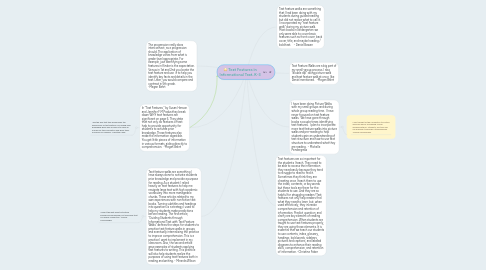Text Features in Informational Text, K-3
von Shelby Skaanes

1. The progression really does interconnect, as a progression should. The application of knowledge varies from what is grade-level appropriate. For example, just identifying some features in Kinder is the expectation. Versus in 1st and 2nd you locate the text feature and use it to help you identify key facts and details in the text. Later, you would compare and contrast in 5th grade. -Megan Bahrt
2. In "Text Features," by Susan Hanson and Jennifer F.M Padua they break down WHY text features are significant on page 6. They state that not only do features of text help to provide opportunity for students to activate prior knowledge. These features also make the information digestible. You get little pieces of information in various formats, aiding directly to comprehension. -Megan Bahrt
2.1. I like the way that they break down the significance of text features. Accessing prior knowledge gives kids a chance to open up a folder for the information and gives them a purpose for reading. -Christine Faber
3. Text feature walks are something I have always done to activate students prior knowledge and provide a purpose for reading. As a student I relied heavily on text features to help me navigate large text with high academic vocabulary into more manageable chunks. These articles related to my own experiences with nonfiction text books. Turning subtitles and headings into questions is a strategy I used to help my students make predictions before reading. The first article, "Guiding Students through Informational Text with Text Feature Walks" defines the steps for students to practice text feature walks in groups and eventually internalizing the practice to improve comprehension. This is a practice I want to implement in my classroom. Also, the second article gave examples of students applying text features to writing. This practice will also help students realize the purposes of using text features both in reading and writing. - Miranda Wilson
3.1. I hadn't thought about activating background knowledge, but obviously that is a logical connection. -Rachel Allmendinger
4. Text feature walks are something that I had been doing with my students during guided reading but did not realize what to call it. I incorporated my "text feature walk" during my picture walk. Most books in kindergarten we only were able to cover basic features such as front cover, back cover, title, and maybe heading / bold text. - Daniel Bowen
5. Text Feature Walks are a big part of my small-group process. I also "double dip" doing picture walk and text feature walk at once, like Daniel mentioned. -Megan Bahrt
6. I have been doing Picture Walks with my small groups and during whole group reading time. I have never focused on text feature walks. We have gone through books a couple times identifying text features. I plan to incorporate more text feature walks into picture walks and pre-reading to help students gain an understanding of text structure and how to use text structure to understand what they are reading. - Michelle Pendergrass
6.1. I also thought of the connection to Picture Walks as well as Previewing a book. Working with ELL students, any time you can preview it scaffolds comprehension. -Rachel Allmendinger
7. Text features are so important for the students I teach. They need to be able to access the information they need easily because they tend to struggle to read to find it. Sometimes they think they are cheating once I teach them to use the index, contents, or key words but these tools are there for the students to use. And they are so helpful for struggling readers! Text features not only help readers find what they need to learn, but, when used effectively, they increase comprehension and retention of information. Predict, question, and clarify are key element of reading comprehension. When students are taught to use text features properly, they are using these elements. It is essential that we teach our students to use contents, index, glossary, headings, bold words, sidebars, pictures and captions, and labeled diagrams to enhance their reading skills, comprehension, and retention of information. -Christine Faber


